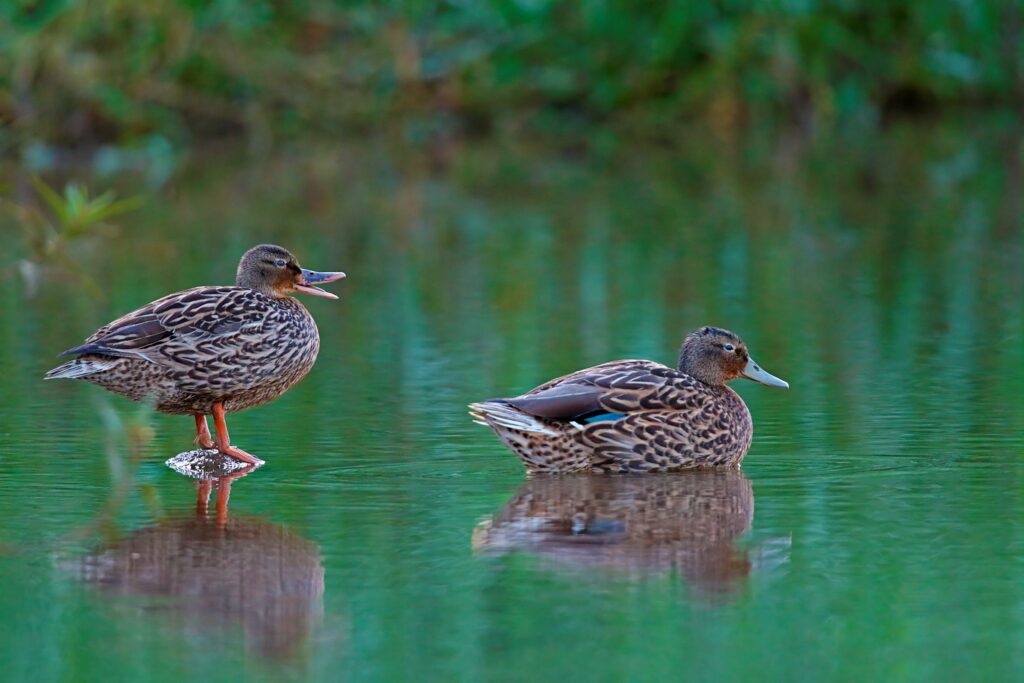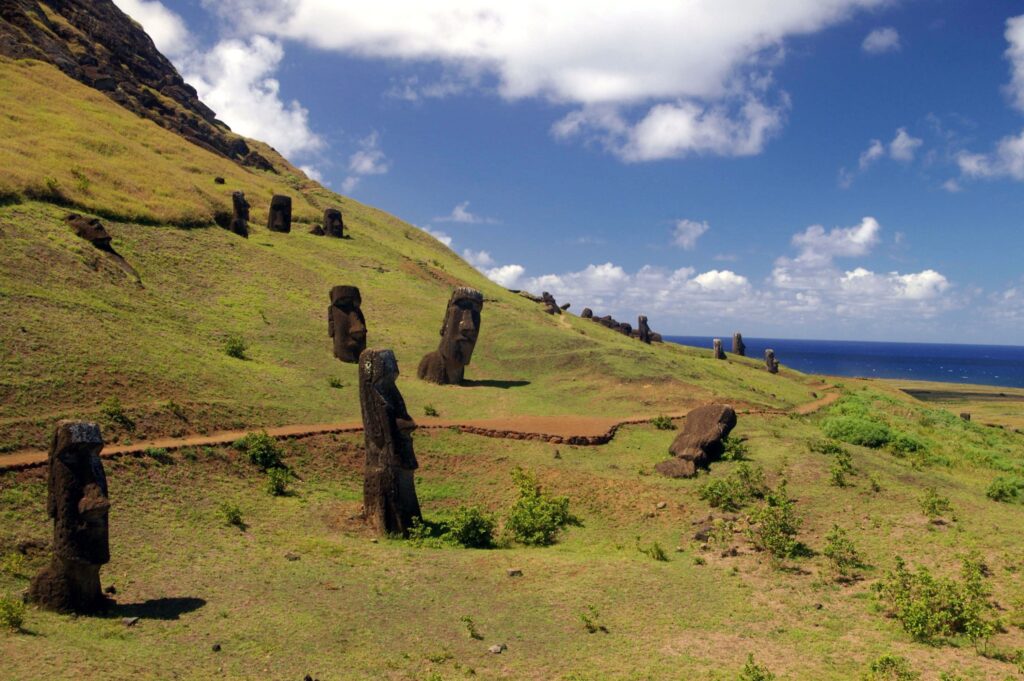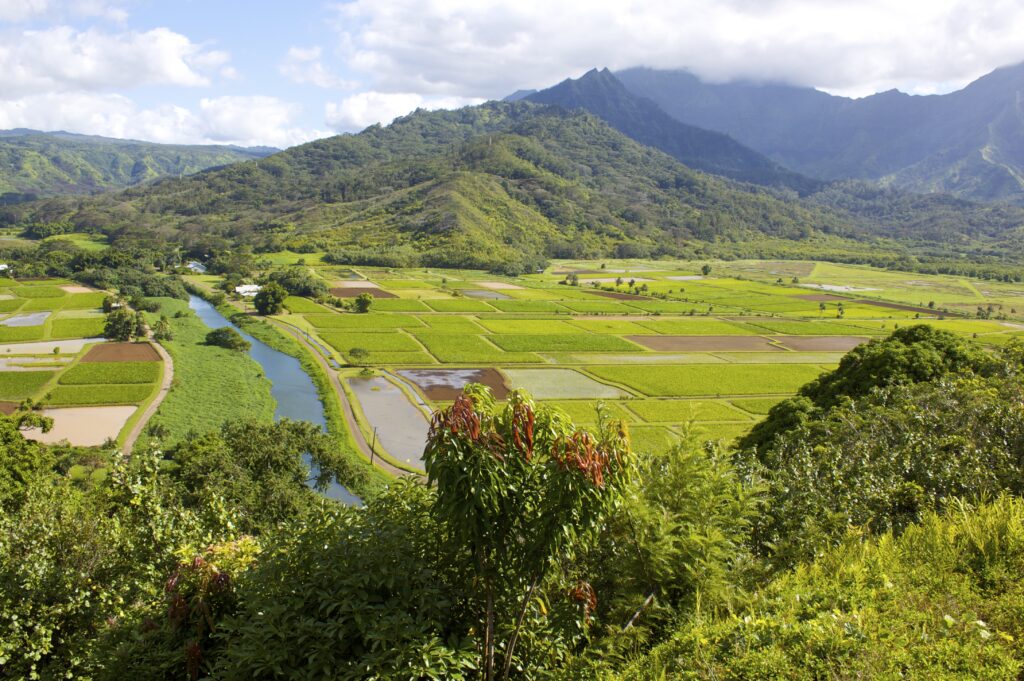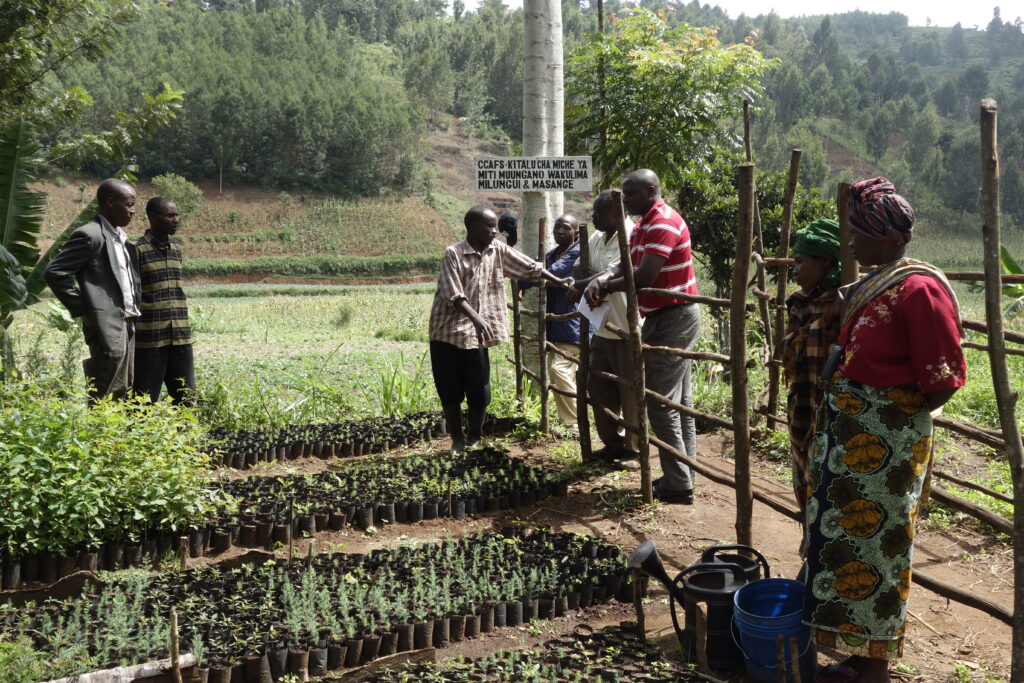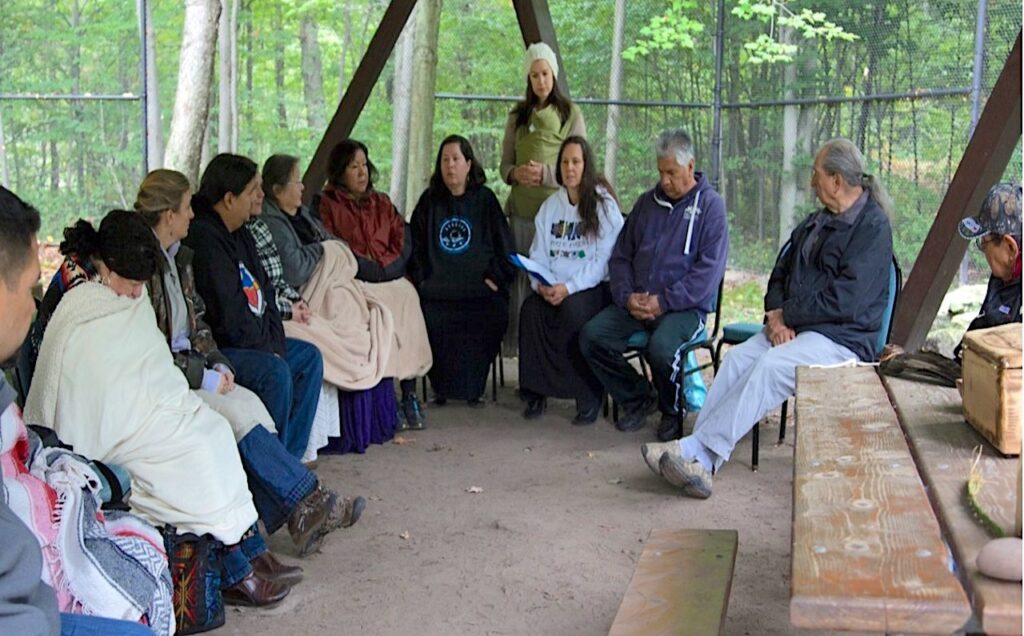How Can Societies Decolonize Conservation?
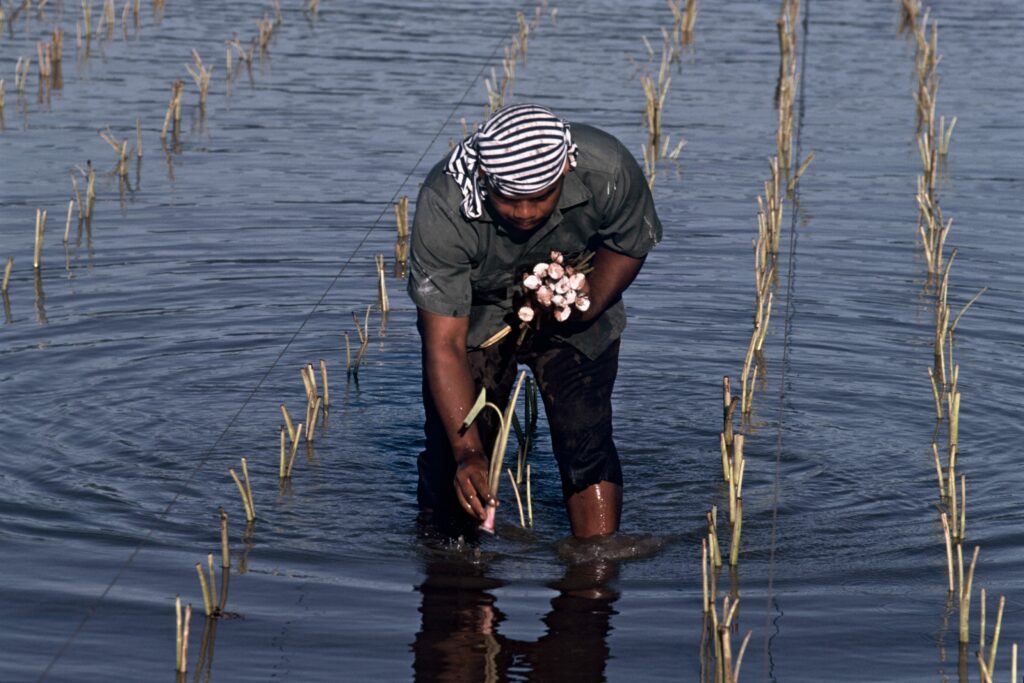
When I (Tim) arrived in Hanalei, Kaua‘i, in 1971 to study irrigation and ancient chiefdoms, biodiversity was not on my mind. As a doctoral student at the University of Michigan, I had read everything I could find about Hawaiian history and traditional farming of taro, a root crop essential to the Hawaiian diet that is grown in irrigated pondfields. My goal was to better understand this ancient form of farming by learning about it in practice—a method called ethnoarchaeology.
Book knowledge could not prepare me for what was happening on these family taro farms.
Water was everywhere. And in the water among the taro, native birds fed. For over 1,000 years, these birds had a co-evolutionary history with the Polynesian farmers who built and maintained the novel aquatic ecosystems for taro and, incidentally, for the birds. But by the time I arrived, both traditional taro farming and the birds that depended on it were in peril.
Four endemic species—Hawaiian ducks, coots, moorhens, and stilts—were endangered because of habitat loss. Some of this was due to coastal developments, but a considerable amount involved farmers abandoning their lands as a result of increasing agricultural costs.
I learned this while standing deep in water and rich mud with a taro-farming family who taught me how to plant, weed, and harvest the crop. Wanting to take a photo, I asked the husband how to climb a nearby hill overlooking his pondfields. Although he had been born in the adjacent farmhouse and had lived there his entire life, he answered, “I never have had time to climb it.” The family worked too hard, seven days a week, to maintain adequate income against farming uncertainty.
This precarious situation was largely caused by foreign-owned sugar plantations that, beginning in the 19th century, disrupted the long-standing kinship between the people and the land. A year after my fieldwork, in 1972, the U.S. Fish and Wildlife Service (USFWS) took unprecedented action to protect the endangered birds in Hanalei. Instead of excluding the people from the land—the typical conservation approach at the time—they decided to support the relationship between the landscape and the people who had intimate knowledge of how to manage it.
We (John and Tim) reflected on this story recently when we were invited by the journal Biological Conservation to present an archaeological view on how to end human domination of nature. We recognize the human drive to dominate the environment as a kind of colonialism that has led to the global biodiversity crisis. Unfortunately, many top-down conservation efforts are rooted in colonialist values and are re-creating the same kinds of harms—only under the umbrella of science.
We believe that any path out of this biodiversity crisis must confront the vestiges of settler colonialism or risk making the cure worse than the disease. The question is: How can societies decolonize conservation?
First, it helps to take a step back and look at what went wrong in history and which humans are to blame. The answers aren’t as simple as they’re often portrayed.
BUSTING THE MYTHS OF BIODIVERSITY LOSS
Well-meaning efforts to explain ecological and biodiversity crises often frame humanity as the problem by oversimplifying the relationship between human actions and biodiversity. They zero in on two disastrous episodes in our shared histories: the migration out of Africa and subsequent extinction of megafauna such as woolly mammoths and giant ground sloths, and the destruction of wild habitats by farmers following the Neolithic Revolution (also called the Agricultural Revolution) about 12,000 years ago.
Without a doubt, whenever humans entered a new habitat, biodiversity decreased. But in the long view, some practices proved more detrimental than others. In many cases, humans have been able to overcome initial declines in biodiversity and manage their ecosystems sustainably for hundreds, if not thousands, of years. The lesson of this long history is that biological and cultural diversity are inextricably linked. It is “biocultural” diversity that must be protected.
For most of the last 300,000 years, Homo sapiens lived in small, highly mobile groups that subsisted by foraging: hunting, fishing, trapping, and collecting flora and fauna (such as eggs and shellfish). The success of these strategies over such a long time suggests they were highly sustainable.
Why should we expect small-scale societies to be so sustainable? It is not population size or density alone that matters, but also cultural norms and economic orientations. Smaller-scale societies are more collective in their approach to property and mutualistic in relation to ecosystems. Rather than maximizing productivity, these groups make subsistence decisions to meet their current needs and minimize risks of future shortfalls. They are in it for the long haul.
One of the most common ways communities achieve these goals is by maintaining a diverse subsistence base. They can do this by moving, settling near a mosaic of natural resources, or managing environments to increase habitat patchiness—and, therefore, biodiversity.
Archaeological evidence from the South American tropics and North American prairies to the East African savannas and the island Pacific demonstrates that the ecosystems foraging groups inhabit and manage can maintain consistent levels of biodiversity for thousands of years.
The transition from foraging to farming is often cited as the next human-induced catastrophe for biodiversity. Farmers and herders do decrease local biodiversity when they increase production of domesticated plants and animals. And there are certainly many examples of agriculture causing irrevocable environmental and social damage. But the story is more complicated than that.
For example, the complete deforestation of Rapa Nui (Easter Island) and the resultant loss of biodiversity was caused by agriculture, resource extraction, droughts, and the introduction of rats. This uneven process unfolded over many centuries after Polynesian farmers arrived. However, by the time the trees were gone, the island’s inhabitants had established effective methods to maintain soil fertility and a sustainable food supply. So, contrary to a popular view that Rapa Nui is the quintessential case of agriculturally induced social catastrophe, the arrival of Europeans was the more likely catalyst of collapse.
There are also many examples of humans stabilizing and reviving biodiversity. For example, the inhabitants of Tikopia and many other Polynesian islands developed sustainable agroforestry methods that mimicked natural forests while providing food and other resources that have supported populations for thousands of years.
So, when it comes to fostering biodiversity, it’s difficult to make a strict division between agricultural and nonagricultural societies.
hierarchY and biodiversity loss
As we see it, the all-too-often overlooked cause of biodiversity loss in the past and present is this: As social and economic hierarchy increases, so does the physical and organizational distance between decision-makers and the environment their decisions affect.
Several factors account for this relationship. Compared to local communities, decision-makers at the top of a hierarchy may have different views of risks and rewards, have less detailed knowledge of the environment, and lack the emotional and spiritual connections to the land that can inhibit local people from destructive practices.
In short, the greater the distance to the managed resources, the greater the chances of people making misguided decisions that result in drastic effects on environments. Two archaeological examples help show why we hold this understanding.
First, Çatalhöyük, in what is now central Turkey, was an ancient settlement of as many as 10,000 people occupied from 7000 B.C. to 5500 B.C. It is one of the best-documented archaeological sites in the world. For well over 1,000 years, the farmers of Çatalhöyük succeeded because they carefully selected microenvironments and niches for cultivating different crops: water-hungry wheats and pulses in wetter areas, drought-tolerant barley in dryer areas. They also continuously adjusted their techniques over the course of the settlement’s history. The biodiversity of flora and fauna in Çatalhöyük’s woodland and wetland habitats appears to have been stable until late in its occupation.
Why did people stop living in Çatalhöyük? One theory points to social tension caused by the development of unequal distributions of agricultural land. Botanical remains reveal increasing amounts of reeds over time, likely the result of people altering wetlands for agriculture. As reeds outcompeted other species, biodiversity diminished. Although Çatalhöyük may never have developed a full-blown hierarchy, cultivation practices and their effects on biodiversity are evident.
Second, the Hawaiian Islands were settled by Polynesians more than 1,000 years ago with initial catastrophic effects on biodiversity. The introduction of pigs and rats had huge impacts on native plant and animal species, especially ground-nesting birds. Farmers initially used shifting cultivation, in which they cycled their fields through active and fallow periods. However, as the population grew, fallow time shortened to sustain more people, and the natural regeneration process was cut short. These changes triggered deforestation, habitat loss, and erosion that also had profound effects on reef health and marine biodiversity.
Eventually, however, communities constructed irrigation and terracing complexes that helped stabilize habitats, minimizing soil erosion and leading to a period of reef restoration from 1400 to 1820. During this period, Hawaiian elites established state-like political groups with supreme kings, considered gods on Earth. They ruled many valley communities spread across whole islands and extracted surpluses of food to support their lifestyles and government. The Hawaiian chiefs, however, expanded the productive irrigation pockets as they asserted ownership over these habitats to serve their own interests.
So, did biodiversity stabilize because of hierarchy or despite it? The irrigation systems proved to be ideal to sustain local communities and provide surpluses without destroying biodiversity. But one theory holds that the agricultural system worked in part because of differential control by elites. Farmers on the irrigation systems, who were bound to their fields, developed local knowledge effective for sustained subsistence and surplus.
Meanwhile, farmers in more marginal uplands faced an ecological struggle but enjoyed freedom from direct control and burdensome tribute. These farmers perpetuated their highly localized knowledge and practices despite a regional level of control. And it is here at the margins of political control that people used their expertise and engaged in conservation.
After 1820, Hawaii became part of a global economy. Farmers had to change their practices to meet the needs of colonizers and later multinational corporations for export production, especially of sugar cane and pineapples. These shifts have not been kind to biodiversity, and the last 200 years have seen the worst damage to Hawaiian reefs.
decolonizing biodiversity CONSERVATION
Collaborating with Indigenous communities in the selection, planning, implementation, and monitoring of biodiversity protection initiatives may seem like an obvious part of the solution today, but that has not always been the case. For most of the 20th century, ecologists thought of human activity as an external disturbance to the natural order.
Based on this misguided belief, many conservationists have thought the best way to preserve threatened ecosystems is to keep people out. Governments have often displaced Indigenous groups and traditional inhabitants from environments that, it turns out, they created and managed effectively over the long term.
Around the world, Indigenous-managed lands meet or exceed the biodiversity levels of conventionally protected lands. But despite the evidence that Indigenous people can lead the way, many national and global conservation efforts continue in the colonial model. The situation is improving, and Hawaii is a noteworthy example.
Because Hawaii experienced so much human-caused environmental destruction—from ancient Polynesian settlement to the modern fossil fuel industry—it might make sense to some conservationists to seek a return to a pre-Polynesian landscape. But that’s not what happened in 1972, when the U.S. Fish and Wildlife Service launched a remarkable effort to protect endangered water birds. They created the Hanalei National Wildlife Refuge in wetland habitat that was originally developed by Native Hawaiians.
At the time, conservation was dominated by the exclusion, and even removal, of human populations from refuges. But in an act of cooperation that was unheard of at the time, the USFWS set aside 160 acres of the 900-acre refuge for taro fields where traditional farming would continue. This win-win situation lowered costs and risks for farmers, whose intimate knowledge of irrigation and soil management was incorporated into a balanced preservation plan.
Across Hawaii today, Native Hawaiians are restoring farming practices that sustain ancient anthropogenic ecosystems and support the islands’ endemic plants, fish, and birds. To celebrate these initiatives, the journal Sustainability recently published a special issue that brought together the largest ever collection of scientific papers authored by Native Hawaiians and kama‘āina (Hawai‘i-grown) scholars. This issue, its editors wrote, shines a light on “Indigenous methodologies that prioritize working relationships and practical applications by directly involving those on the front lines of biocultural conservation and restoration.”
At the same time, new solutions can create new problems. Indigenous groups are internally diverse, and the results of conservation efforts can have unequal impacts on their members. Furthermore, given the complex history of human migration and displacement over the last several centuries, we recognize that local knowledge and Traditional Knowledge will not always be tied to Indigenous people.
In this way, Çatalhöyük offers one more lesson. The Turkish people who live near the site today bear no particular connection to its ancient inhabitants, but they have a vested interest in and local knowledge about what happens there. Midway through the 25-year-long archaeological project at the site, Indigenous archaeologist Sonya Atalay brought her experience, participatory research, and decolonizing practices to this local community.
Through her efforts, community members developed confidence in their knowledge and interests. They took more active roles in supporting and guiding the archaeological research at the site and helping it become more just, equitable, and sustainable. Accomplishing these goals has been a slow process that requires careful listening and, when it became clear that no local partners were available, working with the community to develop the capacity for collaboration.
Hundreds of interviews and years of community-requested archaeological education have yielded a local cultural heritage board that helps with management and planning, an annual festival, a touring archaeological theater troupe, archaeological training for local youth, paid internships for local women, and the off-season use of the dig house for a girls’ school, a health clinic, and a women’s craft cooperative. If Çatalhöyük is any indicator for how to decolonize conservation, even when help is wanted and welcomed, local efforts require time to build trust and capacity.
The global biodiversity crisis requires a biocultural solution in which everyone at the top—governments, universities, nongovernmental organizations—steps back from the controls enough to help empower the people most intimately connected to the land to achieve conservation goals. History has revealed time and again that the greatest harms result from increasing the distance between decision-makers and the people and places affected by their choices.
Large-scale action to protect biodiversity is urgently needed. But if conservationists who seek to end the human domination of nature exclude local stakeholders, they will reproduce the colonialist domination of humans that they so ardently oppose.

































